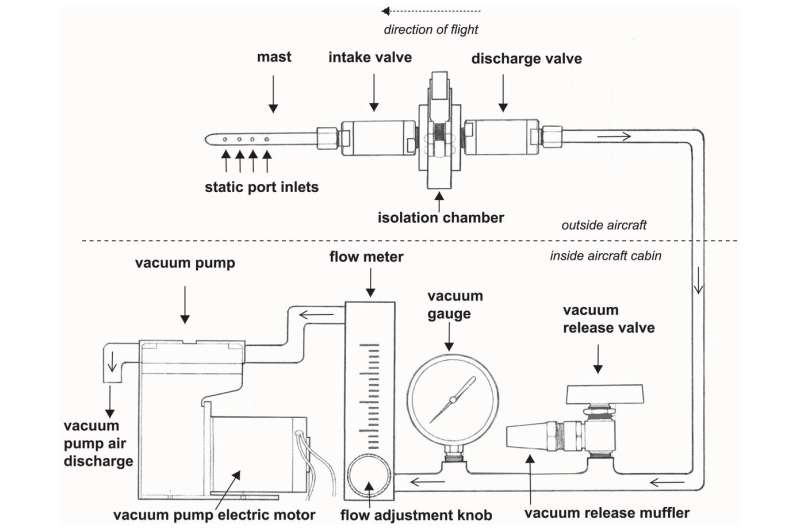This article has been reviewed according to Science X's editorial process and policies. Editors have highlighted the following attributes while ensuring the content's credibility:
fact-checked
peer-reviewed publication
trusted source
proofread
New study reveals widespread presence of environmental DNA in the sky, including allergens and pathogens

A research article titled "Aircraft Surveys for Air eDNA: Probing Biodiversity in the Sky" unveils a revolutionary approach to studying genetic material in the atmosphere. Scientists have developed a durable and sterilizable probe and supporting system to capture air environmental nucleic acids (eDNA) with full-flow filtration and a high-integrity chamber.
Using this innovative probe, the research team aerially mapped environmental DNA by employing a standardized and scalable flight pattern using light aircraft. The aim of the study was to collect bioaerosols, which are aerosolized biological matter, from a range of organisms at various altitudes above major emissions sources, and sequence them for identification.
This work began with an idea to explore, recounts Dr. Kimberly Metris, a faculty member at Clemson University and lead investigator. "I'm a molecular ecologist who works on diverse wild species, from bacteria to bluehead chub to African buffalo. I also fly airplanes, and one summer while I was flying skydivers I had a lot of time to think while climbing to jump run altitude."
"Meteorologically speaking, the conditions were great—10 statute miles visibility, rather calm winds, a rather nice day at the office—but this was during a Saharan dust storm and there was particulate matter visible outside, everywhere. An odd feeling, but it gets the wheels spinning."
What precisely is in the air that we can't see, biologically speaking? This is what she and her co-author set out to explore. "And now we are pushing the boundaries of what we thought we knew about the sky. The sky is not a limit, it is a treasure trove."
The findings of the study are extraordinary. Through the use of their sampling probe and high throughput metagenomic sequencing, the researchers discovered the widespread presence of prokaryotic and eukaryotic eDNA in the atmosphere, reaching thousands of meters into the planetary boundary layer in the southeastern US. Notably, the study detected chicken, cow, and human eDNA at all altitudes flown, including an astonishing 8,500 feet above the ground.
The researchers identified various common plant-based allergens from grasses, weeds, and trees, as well as from species not typically reported in the air, such as garlic, revealing a diverse array of airborne genetic material.
They also discovered pathogenic bacteria and bacteria previously unknown to be present in the atmosphere but found in other extreme environments such as deep-sea sediment.
The sterilizable and reusable sampling probe employed in the study proved to be reliable, limiting sample loss and contamination while filtering genetic material directly from the air. This groundbreaking work enables the mapping of genetic material from potentially all species using aircraft or other flight or stationary methods and connects aerobiome profiles to ground level processes, providing valuable insight into the presence and diversity of genetic material found in the air we breathe.
The implications of this research are far-reaching, with applications in biodiversity, wildlife ecology, biodefense, and pathogen and allergen monitoring. The study's high-throughput amplicon sequencing of DNA from bacteria, vertebrates, and plants demonstrates that bioaerosols can originate from natural processes, such as wind-induced pollination in fields and forests, and human-mediated activities, namely production agriculture, wastewater treatment, and industry practices including hospital waste decontamination.
Airborne DNA profiles detected in the atmosphere reflect surface emissions, allergens, and potential ice and cloud condensation nuclei. The effectiveness of aerosolization is believed to influence the air DNA profiles detected at altitude, suggesting the incorporation of indices of lift and air mass characteristics for standardizing air eDNA surveys. Additionally, the researchers recommend standardized reporting of real-time, empirical flow rates, total air volumes, and sampler type(s) used, as they have crucially different operating airflow requirements.
Biological material in the form of eDNA/RNA can be lifted, carried, and deposited elsewhere by atmospheric mixing, lifting, and buoyancy, potentially leading to biological consequences such as gene flow and hybridization processes.
The atmosphere is powerful and essential to life—The discovery of airborne vertebrate-derived eDNA floating thousands of meters from its origin at Earth's surface suggests that the atmosphere contains biodiverse material, and has implications for biomonitoring and disease surveillance. Scientists can gain insight into the presence, abundance, and distribution of species in an area, providing valuable evidence for identifying individuals or tracing their movements, or monitoring production agriculture from the atmosphere.
This study paves the way for a deeper understanding of airborne genetic material and its implications for various fields of study. By unlocking the secrets of the sky, scientists are gaining new insights into our environment, the air we breathe, and intricate connections among biodiversity on Earth.
More information: Kimberly L. Métris et al, Aircraft surveys for air eDNA: probing biodiversity in the sky, PeerJ (2023). DOI: 10.7717/peerj.15171
Journal information: PeerJ
Provided by PeerJ


















